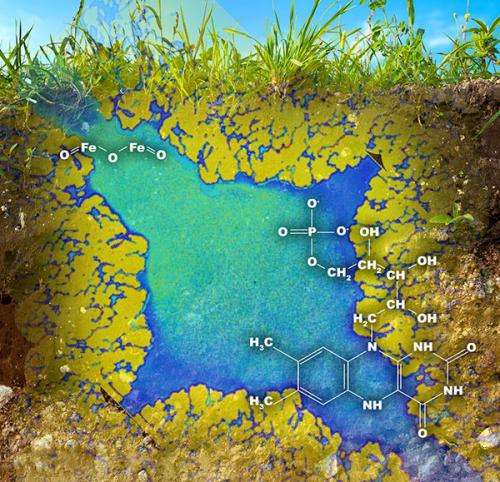Reaction performs differently in different size pores

(Phys.org) —Predictive models of biogeochemical interactions in soils are more accurate and scalable if they consider the reaction chemistry that occurs in distinct soil pore structures, or domains, according to a trio of scientists from Pacific Northwest National Laboratory. The team's findings are the result of integrated computational and experimental pore-scale reaction kinetics studies.
In their studies, they found that the kinetics of reactions involving hematite (Fe2O3) were distinctly different in three domains:
- An advection domain consisting of a large pore, where fluid flows with relative freedom
- A macropore domain, where diffusion dominates but that is well connected to the advection domain
- A micropore domain, where fluid is stagnant and resides in soil aggregates.
Compared to a traditional model, which uses a medium-averaged reaction kinetic value, the three-domain reaction kinetics system more closely represents real-world conditions. Moreover, multi-domain models enable more accurate scaling of reaction kinetics from the pore scale to the field scale. Such models, with their accuracy and scalability, will provide a more accurate view of chemical cycling in the environment. This understanding could assist in developing new environmental remediation techniques and could shed light onto processes coupled to the iron cycle, such as cycling of carbon, nitrogen, sulfur, and other metals. For example, this connection could be important for predicting how subsurface biogeochemistry contributes to carbon exchange with near-surface environments, with impacts on processes that influence food availability, water resources, and extreme weather patterns.
For their studies, the team built a millimeter-sized silicon model, measuring 8.1 mm × 4.5 mm × 0.028 mm, with a pore-scale structure mimicking that found in nature, and coated it with a thin film of hematite, an iron oxide. Iron oxides play a key role in electron exchanges that occur in soil among minerals and microbes. This exchange affects microbial function and the mobility of metals.
The team injected the hematite-coated micromodel with reduced flavin mononucleotide, an effective agent of electron transfer used by microbes. As the reduced flavin mononucleotide gave electrons to and dissolved the hematite, the team studied hematite dissolution both in situ and in real time by using spectroscopy and microscopy tools at EMSL as well as by measuring the concentration of iron in solution.
Researchers at PNNL are continuing to obtain new insights into fundamental biogeochemial processes in complex subsurface environment.
More information: Zhang C, C Liu, and Z Shi. 2013. "Micromodel Investigation of Transport Effect on the Kinetics of Reductive Dissolution of Hematite." Environmental Science & Technology 47(9):4131-4139. DOI: 10.1021/es304006w
Journal information: Environmental Science & Technology
Provided by Pacific Northwest National Laboratory




















